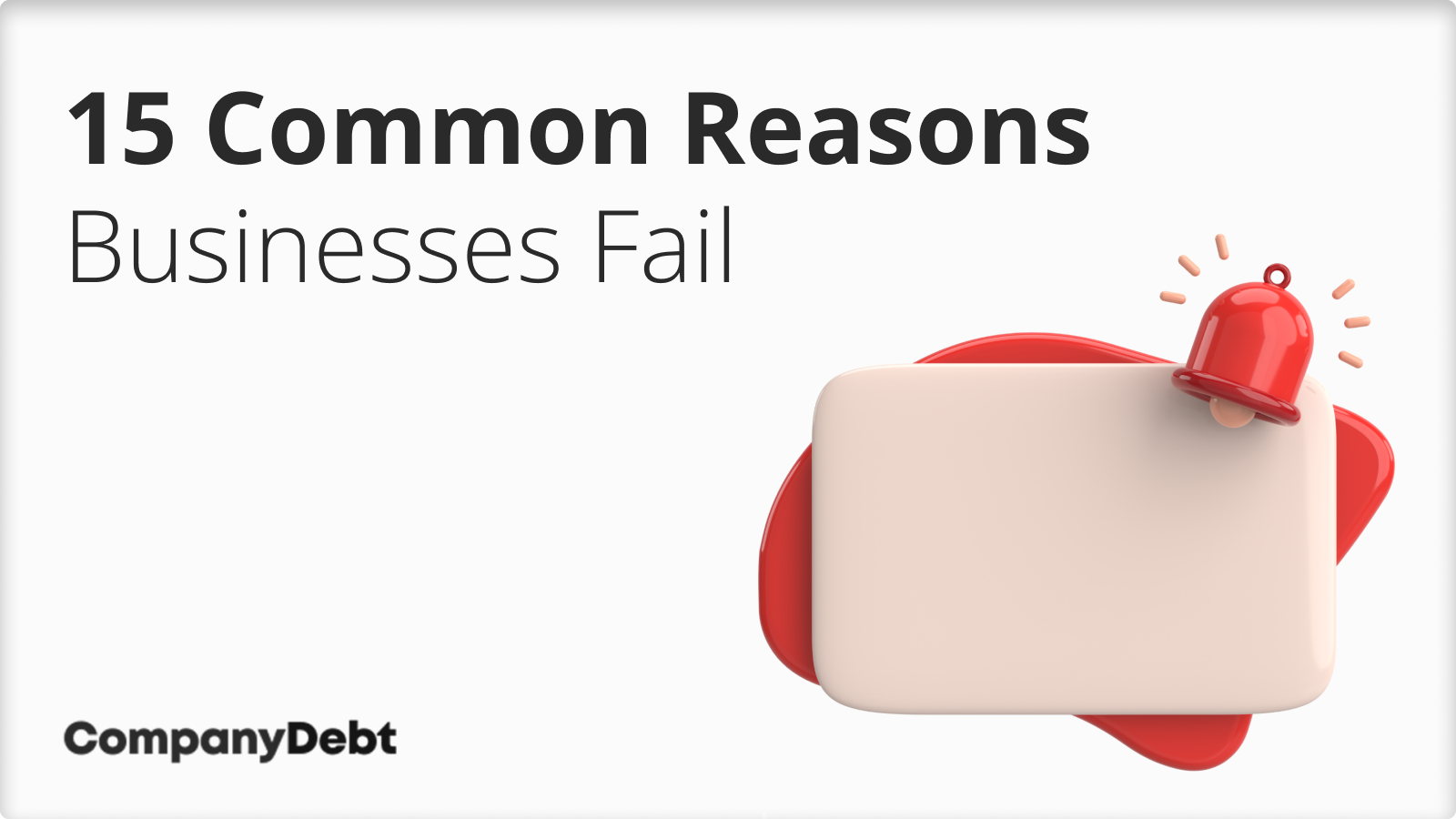
15 Common Reasons Businesses Fail
With company failures hitting a 30-year high in 2023, UK businesses face rising costs and diminishing consumer confidence.
While specific economic conditions are always relevant, business failure has many contributing factors, ranging from financial mismanagement to a lack of leadership. While some are due to simple bad luck, many are preventable.
I’ll explore the most common reasons companies fail, providing insights for business owners to navigate challenges and avoid pitfalls.

| Reason | Description |
|---|---|
| Lack of Leadership | Poor guidance and vision can lead to strategic and operational failures. |
| Improper Planning | Insufficient or flawed planning can result in missed opportunities and disorganised operations. |
| Ignoring Customer Needs | Failing to understand and meet customer expectations can diminish customer satisfaction and loyalty. |
| Inadequate Company Culture | A negative or weak company culture can impact employee morale and productivity. |
| Resistance to Change | Inability to adapt to market or technological changes can lead to obsolescence. |
| Unsustainable Growth | Expanding too quickly without sufficient resources can strain the business. |
| Incompatible Partnerships | Partnering with entities that have conflicting goals or values can cause operational disruptions. |
| Overlooked Competitor Actions | Ignoring competitive actions can result in losing market share. |
| Financial Mismanagement | Poor financial oversight can lead to insolvency or bankruptcy. |
| Unforeseen Global Events | Events like pandemics or economic crises can disrupt business operations. |
| Inability to Pay Bills Promptly | Delays in settling bills can damage supplier relationships and credit ratings. |
| Disruption from Late Customer Payments | Cash flow issues caused by delayed payments from customers can hinder operations. |
| High Employee Turnover | Frequent staff changes can lead to a loss of knowledge and increased recruitment costs. |
| Decline in Sales | Reduced revenue from sales can affect the overall financial health of the business. |
| Persistent Negative Cash Flow | Ongoing cash flow problems can make it difficult to cover operational expenses. |
- Why do Businesses Fail?
- Lack of leadership
- Improper Planning
- Ignoring customer needs
- Inadequate company culture
- Resistance to change
- Unsustainable growth
- Incompatible Partnerships
- Overlooked Competitor Actions
- Financial Mismanagement
- Unforeseen Global Events
- Inability to Pay Bills Promptly
- Disruption from Late Customer Payments
- High Employee Turnover
- Decline in Sales
- Persistent Negative Cash Flow
- Need Help with a Failing Business?
Why do Businesses Fail?
Here are fifteen reasons why businesses fail and what you can do to prevent it from happening.
Lack of leadership
Great leadership involves setting a clear vision, inspiring the team, and making informed decisions. If leadership is weak, a business can suffer from a lack of direction, unmotivated staff, and poor decision-making, which can result in missed opportunities and financial losses.
Leaders are also key in shaping a positive work culture and clear communication. Without this, employee satisfaction can drop, leading to reduced productivity and potentially harming the company’s reputation.
If you’re struggling with this, seek guidance and support from a business mentor or coach; this can have a positive trickle-down effect on your whole organisation.
Improper Planning
Improper planning can be a business’s downfall. It’s not just about having a plan in place but ensuring that it considers all eventualities. When a company doesn’t adequately prepare for the future, it may miss critical financial targets, misunderstand its market, or fail to allocate resources where they are most needed.
As an insolvency practitioner, I’ve seen too many businesses suffer because their plans weren’t robust enough to handle downturns or market changes. It’s crucial to regularly consider potential economic shifts, supply chain issues, and other risks. This way, you can stay resilient and adapt when things don’t go as expected.
Ignoring customer needs
Ignoring your customers is a sure way to fall behind competitors who listen better. When you don’t pay attention to what your customers want, you’re bound to lose them to businesses that do.
Understanding customer needs isn’t rocket science. It involves market research, surveys, and listening to feedback. Use this information to shape products and services that truly meet their expectations.
Also, be responsive. If customers have complaints, address them promptly. This not only fixes the immediate issue but also shows your customers that you value their feedback and are committed to their satisfaction. It’s about building trust and loyalty, which are essential for long-term success.
Inadequate company culture
A poor company culture can make it tough to attract and keep good employees, which can lead to business failure.
Company culture is about the values, beliefs, and behaviours that are common within your organisation. It’s shaped by leadership, the company’s mission and vision, and how employees are treated.
A strong company culture is supportive, inclusive, and respectful. Your employees should feel valued and respected, with opportunities for growth and development. When people enjoy where they work and feel appreciated, they’re more likely to stay and contribute to the company’s success.
Resistance to change
Resistance to change can be a significant obstacle for any business. In practice, I’ve observed that companies which resist adapting often find it challenging to stay afloat.
Businesses may resist change due to fear of the unknown, potential disruption, or simple complacency. However, failing to evolve can mean missing out on new opportunities or being slow to respond to competitive threats, which can ultimately lead to business failure.
To overcome this, it’s essential to foster a culture that embraces change. Start by clearly communicating the benefits of proposed changes and involving employees in the process. Provide training and support to help your team adapt.
Regularly reviewing and updating business processes can help ensure your company remains agile and competitive. It’s not just about surviving; it’s about thriving in a constantly changing market.
Unsustainable growth
Rapid expansion often outpaces a company’s operational capabilities, leading to a multitude of problems. In the UK, several businesses have faced challenges due to unsustainable growth.
In recent years, Patisserie Valerie expanded quickly but failed to maintain adequate financial controls, which ultimately led to its collapse. Similarly, Maplin, the electronics retailer, expanded its store network aggressively without sufficient demand, resulting in financial strain and eventual administration.
To mitigate these risks, align growth with strategic planning. Ensure your infrastructure, from supply chains to customer service, can scale appropriately. Financial planning is crucial to maintaining healthy cash flow and preventing debt from overshadowing growth benefits.
Incompatible Partnerships
Incompatible partnerships can impede business success. If a company aligns with another whose reputation or product quality is poor, it can tarnish its own standing in the market. Customers often associate a business’s offerings with those of its partners, so a mismatch can lead to a loss of customer trust and business.
A notable example here is the collapse of Carillion. The construction and facilities management giant had numerous partnerships, but a lack of alignment and financial transparency among its partners contributed significantly to its downfall. Similarly, BHS faced difficulties when it was sold to a buyer without sufficient retail experience or financial backing, leading to its eventual closure.
Overlooked Competitor Actions
Keeping track of competitors is key to a business’s success. If a company doesn’t pay attention to what its competitors are doing, it risks losing its place in the market. Competitors might launch new products or start powerful marketing campaigns that draw in customers.
Kodak famously overlooked the shift to digital photography, allowing competitors like Canon and Nikon to capture the market. Another example is Blockbuster, which ignored the rise of online streaming services like Netflix. Their failure to adapt and respond to these new threats led to their eventual demise.
Financial Mismanagement
Financial mismanagement is one of the primary reasons businesses fail. Poor financial oversight can lead to insolvency. In the UK, several high-profile companies have fallen victim to this.
Thomas Cook, the travel giant, collapsed in 2019 due to a combination of massive debt and poor financial planning. Despite its long history and brand recognition, Thomas Cook couldn’t manage its financial obligations, leading to its liquidation.
Another example is Woolworths, which went into administration in 2008. Poor financial decisions, such as failing to adapt to changing retail environments and managing debt, were major contributors to its downfall.
Regular financial audits and reviews can help identify potential issues early on, allowing businesses to take corrective action before problems escalate.
Unforeseen Global Events
Businesses are vulnerable to unexpected global events like wars, natural disasters, and recessions. These events can interrupt supply chains, damage a business’s reputation, and lead to a drop in customer demand.
To protect themselves, businesses should have a plan ready for different types of crises. They should also spread their supply chain risk by using multiple suppliers and invest in risk management.
Being prepared in advance helps businesses handle sudden global challenges better, improving their chances of surviving and keeping their operations running smoothly.
Inability to Pay Bills Promptly
One of the most common reasons for insolvency is the inability to pay bills on time. When businesses delay payments to suppliers and creditors, it can severely undermine relationships and lead to a cascade of financial troubles.
For example, Phones 4U, a major mobile phone retailer, went into administration in 2014. One of the critical factors in its collapse was its inability to secure payments from network providers, leading to severe cash flow issues and, ultimately, its inability to pay suppliers and creditors.
Another case is Hibu, formerly known as Yell Group, which faced significant financial difficulties due to delayed payments and mounting debts. The company struggled to manage its obligations, which led to a major restructuring process to avoid insolvency.
Disruption from Late Customer Payments
While managing your own bills is crucial, disruptions from late customer payments can be equally damaging. When customers delay payments, it can create cash flow issues that ripple through your entire operation, making it difficult to meet your financial obligations.
A notable example is the collapse of Debenhams. The department store chain faced significant cash flow problems partly due to late payments from customers and issues with credit control. This made it challenging for Debenhams to pay its suppliers and manage its operational costs effectively.
To mitigate the risks of late customer payments, businesses should establish clear payment terms and enforce them rigorously. Offering early payment discounts or implementing stricter credit control measures can also help. Regularly reviewing accounts receivable and following up promptly on overdue invoices is essential to maintaining healthy cash flow.
High Employee Turnover
High employee turnover can indicate underlying issues such as poor working conditions, inadequate compensation, or limited career progression opportunities. Such turnover can lead to productivity losses and a decline in service or product quality.
To combat this, businesses may focus on fostering a positive workplace culture, ensuring competitive compensation packages, and offering professional growth opportunities. Investing in employee development can enhance skill sets and job satisfaction.
Addressing the root causes of high employee turnover can bolster productivity and maintain quality, contributing to the business’s overall stability and success.
Decline in Sales
A decline in sales may suggest customer migration to competitors or a general reduction in market demand, presenting a challenge for businesses to manage their operating expenses.
To reverse a sales slump, companies can refine their marketing approaches and sales tactics or innovate with new product or service offerings. Additionally, promotions and discounts may serve to draw in new clientele while retaining current customers.
Enhancing sales is vital for covering costs and ensuring business viability.
Persistent Negative Cash Flow
Persistent negative cash flow indicates a company consistently spends more than it earns, a trajectory that can culminate in insolvency.
To correct this imbalance, a business may cut costs or boost revenue. Seeking external funding from investors or lenders is another avenue to improve financial stability.
Addressing cash flow issues is essential to avert the risk of insolvency and position a business for successful operation.
Need Help with a Failing Business?
At Company Debt, we specialise in delivering expert advice and implementing rescue procedures to salvage struggling businesses. Don’t hesitate to reach out for a confidential, no-obligation consultation to discuss your unique circumstances. We are here to help and offer a complimentary initial consultation to provide insights into your options.








